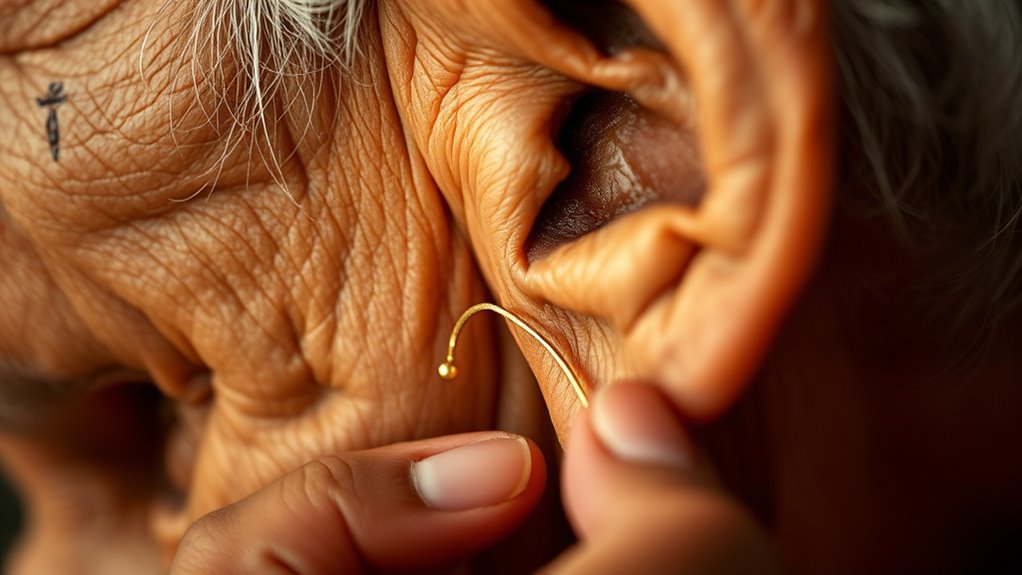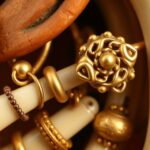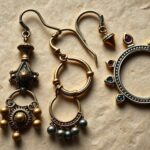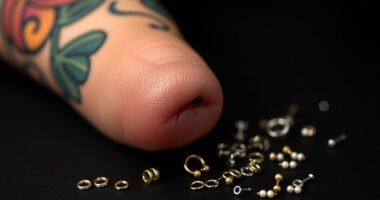The ancient secret behind ear-lobe piercing traditions lies in its deep cultural roots spanning over 4,000 years. Societies like those in Egypt, India, and Mesopotamia used piercings as symbols of social status, spiritual beliefs, and rites of passage. Over time, these meanings evolved, blending with fashion and personal expression. If you explore further, you’ll discover fascinating stories that connect ancient symbolism with today’s modern trends and cultural significance.
Key Takeaways
- Ear-lobe piercing originated over 4,000 years ago in ancient Egypt as a symbol of wealth and spiritual devotion.
- In ancient cultures like India and Mesopotamia, it marked rites of passage, social status, and spiritual openness.
- Piercings conveyed identity, belonging, and protection against evil spirits in various societies.
- Historically, piercings reflected social hierarchy and cultural symbolism, often indicating maturity or readiness for marriage.
- The practice evolved from sacred rituals to a modern form of personal expression, retaining its deep cultural and historical significance.

Have you ever wondered why ear-lobe piercing has become such a widespread tradition across different cultures? It’s more than just a fashion statement; it carries deep-rooted cultural symbolism and a fascinating historical evolution. Throughout history, societies have used ear piercings as a way to communicate identity, social status, and spiritual beliefs. These traditions date back thousands of years, revealing how piercing practices have evolved and adapted over time.
Ear-lobe piercing symbolizes identity, status, and spirituality across cultures and history.
In ancient civilizations like Egypt, Mesopotamia, and India, ear-lobe piercing was often associated with rites of passage. For example, in Egypt, mummies with pierced ears have been discovered dating back over 4,000 years, indicating that piercing was seen as a sign of wealth or religious devotion. In India, ear piercing is intertwined with spiritual symbolism, representing the opening of the mind to divine knowledge. These practices weren’t just about adornment; they signified belonging, maturity, and sometimes even protection against evil spirits. As cultures evolved, so did the meanings behind ear piercings. In some societies, a pierced ear indicated social status or wealth, while in others, it marked coming-of-age or readiness for marriage.
The historical evolution of ear-lobe piercing also reflects changing attitudes towards body modification. In medieval Europe, piercings were less common and often frowned upon, seen as rebellious or associated with lower classes. But with the influence of explorers and traders, the practice spread to different parts of the world, gaining new meanings along the way. During the 20th century, ear piercing shifted from a cultural or spiritual act to a popular fashion trend, especially with the rise of punk and hip-hop cultures. This transformation highlights how a once sacred practice became a symbol of individuality and self-expression.
Today, ear-lobe piercing continues to evolve, blending cultural symbolism with modern aesthetics. While some still see piercing as a rite of passage or a spiritual act, many view it purely as a form of personal style. Yet, the historical roots remain embedded in the tradition, reminding us that ear piercing isn’t just about decoration—it’s a language of identity that has traveled through time and across continents. The practice’s adaptation over centuries also demonstrates how social attitudes towards body modification have shifted, making it a more accepted form of personal expression in contemporary society. Whether for cultural reasons or personal choice, the persistence of ear-lobe piercing underscores its enduring significance, rooted in a rich history of symbolism and social evolution.
Frequently Asked Questions
How Did Ancient Cultures Develop Ear-Lobe Piercing Techniques?
You might wonder how ancient cultures developed ear-lobe piercing techniques. They often used cultural symbolism and artistic expression to craft meaningful designs, reflecting beliefs, social status, or identity. Techniques evolved through trial, error, and shared knowledge, with communities passing down skills and symbolism across generations. These methods became deeply rooted traditions, turning ear-lobe piercing into an art form that connects individuals to their cultural heritage and personal stories.
Were Ear Piercings Used for Spiritual or Ritual Purposes Historically?
You might find that ear piercings historically held deep spiritual symbolism and ritual significance. Many cultures used earrings not just as adornment but as symbols of social status, protection, or spiritual beliefs. For example, some tribes believed piercings connected them to ancestors or divine forces. These practices often marked rites of passage, emphasizing their importance beyond mere decoration, and showing how deeply intertwined ear piercing was with spiritual and ritual traditions.
What Materials Were Traditionally Used for Ear-Lobe Jewelry?
You might wonder what materials and craftsmanship were used in traditional ear-lobe jewelry. Historically, people used materials like gold, silver, bone, shells, and beads, chosen for their availability and symbolic meanings. Skilled artisans crafted these pieces with meticulous care, ensuring durability and beauty. The craftsmanship reflected cultural values, often making the jewelry not just adornment but also a sign of status, spirituality, or protection.
How Did Ear-Lobe Piercing Methods Vary Across Different Civilizations?
You’ll find that civilizations across the world approached ear-lobe piercing with astonishing diversity, turning it into a powerful form of cultural symbolism and artistic expression. In some societies, piercing methods involved elaborate rituals and primitive tools, while others used more refined techniques with jewelry as status symbols. These varied approaches reveal how deeply intertwined ear piercing is with identity, tradition, and social standing, making it a fascinating global mosaic of cultural practices.
Are There Any Myths or Legends Associated With Ear-Lobe Piercing Traditions?
You might be fascinated to learn about the mythical origins and legendary stories behind ear-lobe piercing traditions. Many cultures believe these practices are linked to sacred or mystical significance, often involving stories where ear piercing grants protection, status, or spiritual power. These legends add depth to the tradition, turning a simple act into a meaningful ritual passed down through generations, enriching its cultural and mythical significance.
Conclusion
Now that you know the ancient roots behind ear-lobe piercing, you can appreciate its deeper meaning. It connects you to history, honors tradition, and celebrates identity. It’s more than just jewelry; it’s a symbol of culture, a mark of heritage, a reflection of history. Embrace the story behind your adornment. Wear it with pride, honor the past, and carry forward the legacy. Because every piercing isn’t just about beauty — it’s about belonging, heritage, and history.
















